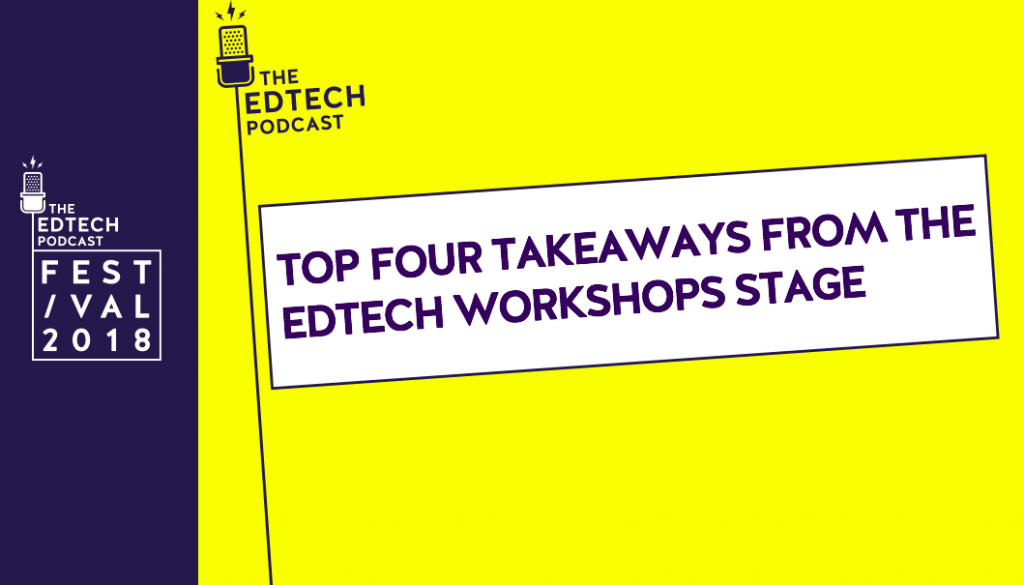GUEST POST: TOP FOUR TAKEAWAYS FROM THE EDTECH WORKSHOPS STAGE

This is a Guest Post article by Nick Novak (Startup Advisor, Impact Investor & Former CCO at Arbor Education) and forms one of a series of “takeaways” from The Edtech Podcast Festival. This is the takeaway article from the edtech stage at the event. See the rest of our series for takeaways on “educators”, the LIVE podcast stage and more.
The 2018 Edtech Podcast Festival, recently hosted at Plexal in East London, brought together a full day of learning and sharing from some of the most influential voices in ‘ed’ and ‘tech’. From the inspiring keynote of Dr Jess Wade on The Power of the Polymath, to the hands-on makerspaces led by Lego and pi-top, to the lunchtime canoeing (yes, really!), it was a brilliant event with something for everyone. Here are my top 4 takeaways from the Edtech Workshops.
1. Put students at the heart of everything
Jamie Brooker knows a thing or two about reaching scale in edtech. After all, he’s the co-founder of the massively popular Kahoot, which is used by over 100,000,000 students every month from classrooms all over the globe. At the heart of his talk on the what it takes to build a successful edtech product was one simple but sometimes forgotten idea: The student comes first.
“We often don’t design products for learners, we design for the people who buy them,” Jamie shared as part of his presentation. “Products that aren’t built to engage students, end up with students being disinterested.” It’s a point that’s fits neatly alongside recent statements by United Learning’s Group Director of Technology Dominic Norrish concerning the ‘Implementation Effect.’ Essentially, if you want your product to stick around and students are your target user, then every part of your design should be focused on the most engaging experience possible. If students are active and engaged, then the buyers and teachers will follow. When students aren’t interested, your product is at risk.
2. Impact isn’t optional
One would hope that nearly all edtech companies are in this industry in order to improve outcomes for students. As Richard Taylor put it during his talk, “We aren’t in the edtech business, we are all in the education business. And you are more likely to make money in education if you can deliver something that actually has a impact on student outcomes.”
Teams like UCL’s Educate and Edtech Impact are providing a path for edtech businesses to put science behind their products and illustrate their positive impact on students. It’s an emerging trend but, if Larry Fink’s 2018 letter to investors is any indication, measuring how a business positively impacts society may be the new standard.
3. Build better products with LXD
Zahra Davidson, co-founder of Enrol Yourself and leader of London’s LXD Meetup, took the audience through several innovative and unusual approaches to designing learning spaces and products. The objective was to “break down assumptions about what learning looks like” by exploring the practice of Learner Experience Design (LXD), which is the process of leveraging design-thinking in curriculum development. Building on the student-centric nature of the talks of the day, Zahra gave some brilliant guidance on LXD best practices for all education settings (not just products), including:
- Put students in control: Let students control their pace and content.
- Create space for feedback: Build functionality and time to gather feedback alongside any questions being asked in order to quickly clear up misconceptions.
- Contextualize learning to the real world: Grounding learning in reality of today, instead of a sci-fi world of a game, may make it easier to grasp and apply new concepts.
4. The single rule when expanding into China
The Chinese edtech investment market continues to grow, with over $1.2B invested in edtech businesses in 2016 and the average Chinese family spending 7x more on education than comparable American families. Sounds great, but how easy it is to jump into the Chinese market? Matt Johnson from Cooley gave the audience some insight.
“It’s all about working and collaborating with a partner,” Matt explained at the top of his talk. “Investment needs to made locally. Be ready to put the money back into China.” It’s not only cultural norms that your team may need to adjust to, it’s the simple fact that China is looking to invest in China. Breaking into the market likely means building a local team and reinvesting all revenue directly back into the community – don’t expect Chinese wallets to feed your UK accounts. If you’re looking for some resources to make your own jump, Cooleygo.com has a totally free collection of essential documents to help you get going.
Thanks Nick! You can register your interest for our next festival here.



